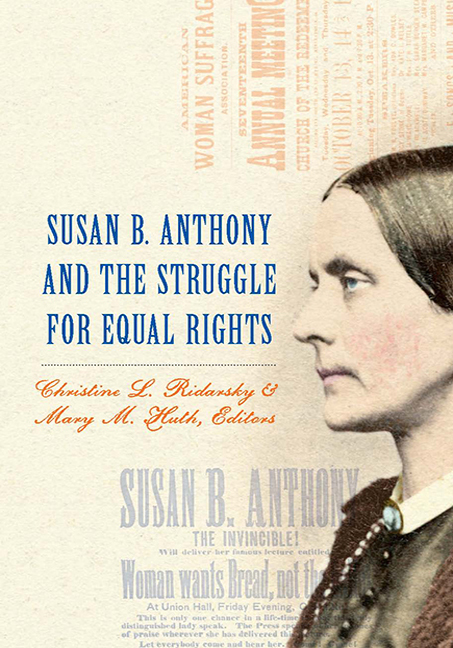Book contents
- Frontmatter
- Dedication
- Contents
- Preface
- Introduction
- Part 1 Constructing Memory
- Chapter 1 We Shall Be Remembered: Susan B. Anthony The Politics of Writing History
- Part 2 Anthony and Her Allies
- Part 3 Broadening the Boundaries of the Equal Rights Struggle
- Part 4 Reconstructing Memory
- List of Contributors
- Index
Chapter 1 - We Shall Be Remembered: Susan B. Anthony The Politics of Writing History
from Part 1 - Constructing Memory
Published online by Cambridge University Press: 09 May 2017
- Frontmatter
- Dedication
- Contents
- Preface
- Introduction
- Part 1 Constructing Memory
- Chapter 1 We Shall Be Remembered: Susan B. Anthony The Politics of Writing History
- Part 2 Anthony and Her Allies
- Part 3 Broadening the Boundaries of the Equal Rights Struggle
- Part 4 Reconstructing Memory
- List of Contributors
- Index
Summary
Surveying the scale and scope of the changes Susan B. Anthony helped usher in on behalf of women is dizzying. She is, of course, most known for her advocacy of woman suffrage, becoming upon her death—and still today—the movement's most famous proponent. Anthony's iconic stature led the US Mint to put her face upon the dollar coin—the first woman featured on US currency. Unmarried with no children, Anthony devoted her life to the cause. The work consumed her: traveling thousands of miles, speaking almost nightly for months on end, managing a voluminous correspondence, writing editorials, entertaining reporters, lobbying Congress, helping to organize annual conventions for the National Woman Suffrage Association (NWSA, a national organization she helped found and lead), offering guidance to state societies, participating vigorously in state suffrage canvasses, spearheading protest initiatives, organizing petition drives, and more. The pace and scale would have overwhelmed many. Yet Anthony, with a seemingly bottomless reserve of energy, extended her reach still further. She was involved in temperance, equal-wage, and antislavery campaigns, to name a few. And in the final decades of her life, Anthony tackled what many are still laboring to understand today: the history of women's rights in the nineteenth century. Of all of Anthony's legacies, her role as a movement historian is perhaps the most underappreciated, yet it is arguably among the most important and most enduring.
In the decades after the American Civil War, Anthony spearheaded and managed one of the most ambitious projects of her career: the massive three-volume History of Woman Suffrage. She authored this sweeping work with her best friend, Elizabeth Cady Stanton, and fellow New York suffragist Matilda Joslyn Gage. The three spent ten long years on the project, and had it not been for Anthony's dogged insistence, the work might never have been completed. Together, these tomes (numbering roughly one thousand pages each) took readers on a kaleidoscopic tour of women's rights activism across one hundred years, from the American Revolution of 1776 to 1886, the date of the final volume's publication. No other suffragists produced anything comparable. Indeed, nothing like it exists in the annals of American reform. The History is a unique work. Yet its significance and impact has not been adequately understood.
- Type
- Chapter
- Information
- Susan B. Anthony and the Struggle for Equal Rights , pp. 15 - 56Publisher: Boydell & BrewerPrint publication year: 2012

